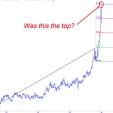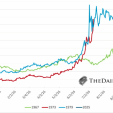Is It Time To Sell Stocks and Buy Bonds?
After Weak Jobs Report, Prudent To Recheck Big Picture

On January 9, we described the importance of considering allocation adjustments as the observable evidence shifts. Friday’s monthly jobs report falls into the “observable and unexpected shift” category. From Bloomberg:
The 74,000 gain in payrolls, less than the most pessimistic projection in a Bloomberg survey, followed a revised 241,000 advance the prior month, Labor Department figures showed today in Washington. The median forecast of 90 economists called for an increase of 197,000. The unemployment rate dropped to 6.7 percent, the lowest since October 2008, as more people left the labor force.
Does The Soft Labor Market Call For Allocation Adjustments?
There are three major parking places for investor cash:
- Stocks (long)
- Bonds
- Stocks (short)
While many believe the key to success is picking the winning stock, the most important decision in terms of protecting and growing your capital is how to allocate prudently between the three buckets shown below. For example, if you had a high allocation to stocks between 1992 and 2000, you did quite well, regardless of which stocks you selected. Conversely, stock selection alone would not have allowed you to sidestep significant losses between October 2007 and March 2009; a period that saw the S&P 500 drop over 50%.

The buckets above speak to opportunity costs for our limited investment capital. If we monitor the market’s pricing mechanism with an open mind, we can greatly increase our odds of allocating in a reasonable manner.

S&P 500 – Big Picture
Obviously, we would all like to shift our capital from the stock bucket to the bond bucket before stocks experience their next inevitable bear market. One way to assist us in trying to meet that admirable goal is to monitor the battle between economic conviction and economic fear. The daily chart of the S&P 500, along with the 50-day and 200-day moving averages can act as an economic monitoring device. If the present day chart begins to morph into something similar to the 2001 and 2007 charts, our concerns will increase. As of Friday afternoon, the chart still looks healthy from a longer-term perspective.

Fed Has Reemerged As Biggest Factor
Prior to Friday’s way-below-consensus labor report, the market believed the Fed had embarked on a tapering journey that would eventually bring QE to an end. The itinerary for the Fed’s taper journey may have to be amended. From CNBC:
Faced with high unemployment and stubbornly low inflation, the Federal Reserve should be ramping up—not scaling back—its monetary stimulus, a top Fed official says. The central bank, charged by Congress to aim for an economy that has enough jobs and also stable prices, “could do better with respect to both of its congressionally mandated objectives by adopting a more accommodative monetary policy stance,” Narayana Kocherlakota, president of the Minneapolis Federal Reserve Bank, said Thursday at a town hall event at the regional bank’s headquarters.
Does Evidence Say Move To Bonds?
The fundamental rationale for monitoring the ratio of stocks (SPY) to bonds (AGG) below was described in detail on January 8. The market’s pricing mechanism is saying stay with stocks based on the January 10 chart below. If the stock vs. bond ratio morphs into a look similar to the corrective periods highlighted, our concerns will increase since it would indicate growing doubt about the economy.

Does Evidence Say It Is Time To Short?
In The Best 2014 Investment Advice, we described the fundamental rationale for tracking the ratio of longs-to-shorts (SH). The answer still sides with the economic and stock bulls. If the long vs. short ratio morphs into a look similar to the highlighted economic uncertainty periods, our market model will consider reducing our exposure to equities; a shift that would be based on observable deterioration in the market’s tolerance for risk.

Investment Implications – Hurry Up And Wait
The stock market’s bullish momentum has slowed since the last New Year’s Eve partygoer left Times Square, but only to a “pay close attention” rather than “run for the exits” point. If the market is telling us stocks remain more attractive than bonds, and longs remain more attractive than shorts, that sends two messages:
- The perception of future earnings, economic growth, and geopolitical dynamics has not deteriorated to concerning or “risk-off” level.
- Consequently, some patience remains prudent with our stock-related investments.
If the observable evidence and hard data deteriorate in a meaningful way, our market model will call for further incremental reductions in equity exposure. For now, we continue to maintain significant positions in U.S. stocks (VTI), financials (XLF), energy (XLE), technology (QQQ), small caps (IWM), Europe (FEZ), and global stocks (VT). We will continue to let the market be our guide.
This entry was posted on Friday, January 10th, 2014 at 3:12 pm and is filed under Stocks - U.S.. You can follow any responses to this entry through the RSS 2.0 feed. Both comments and pings are currently closed.

















